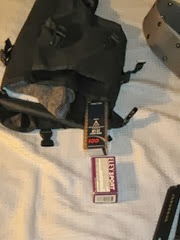The 20th century is over and it left a long, blood-stained path behind it. Unfortunately our political class is married to it, still, and continue to campaign like the 20th century is still going on. The politics of division such as 'The War on Women' or wanting to put a huge, government led system down for 'health care' ignore the realities of the 21st century. These realities I've talked about before in Dawn of a New Era, and those drivers are the ones that are currently shifting the basis for what we know as our modern civilization. Yet the 20th century, for all its problems, has also blessed us with an infrastructure that is vital for the immediate continuance of civilization in the 21st century: electricity, potable water, sewage systems, paved roads, airports, and a vast web of pipelines. Without this infrastructure in all of its parts modern civilization quickly decays. A major disruption of the pipeline system crossing the Mississippi River would cripple the entire Nation. I outlined five major events that are either cyclic (meaning they happen on a regular basis due to forces of nature) or a singular event that has its now understood predecessors so that it is not cyclic, as such, but part of an understood and ongoing process, and all will happen at some point in time to North America.
I will add to those yet another: solar weather. In testimony on 12 SEP 2012 to the House Homeland Security Subcommittee on Cybersecurity, Infrastructure Protection and Security Technologies, the head of the National Protection and Programs Director gave us this on the topic of solar weather:
Solar Weather is created as a result of massive explosions on the sun that may shoot radiation towards the Earth. These effects can reach the Earth in as little as eight minutes with Solar Flare X-rays or over 14 hours later with a Coronal Mass Ejection (CME) plasma hurricane. An extreme CME is the Department’s biggest Solar Weather concern. It could create low-frequency EMP similar to a megaton-class nuclear HEMP detonation over the United States, which could disrupt or damage the power grid, undersea cables, and other critical infrastructures. The United States experiences many solar weather events each year, but major storms that could significantly impact today’s infrastructures are not common but have previously occurred in 1921 and 1859 and possibly in several other years prior to the establishment of the modern power grid. The U.S. Department of Energy and utility owners and operators have been focusing on potential threats and steps that utilities can take to reduce possible impacts.6 Work is underway in cooperation with a number of federal agencies including the: National Aeronautics and Space Administration (NASA), Nation Oceanic and Atmospheric Administration (NOAA), United States Geological Survey, Department of Energy, Department of Defense, and DHS with industry support and participation to ensure this threat is understood.
The concept of 'ensuring the threat is understood' for a known threat that is understood is verbiage for 'we want to get a few bureaucrats to hold meetings and write reports that might have some conclusions in a decade'. Just so you know what that means.
The 1921 storm fed power into the nascent grid and took the telegraph service down with blown fuses and damaged equipment and lasted from 13-15 MAY 1921. Over at Space Weather there is a somewhat longer look at the effects of the 1921 event:
May 13, 1921 - The New York Railroad Storm - At 7:04 AM on May 15, the entire signal and switching system of the New York Central Railroad below 125th street was put out of operation, followed by a fire in the control tower at 57th Street and Park Avenue. Railroad officials formally assigned blame for a fire destroyed the Central New England Railroad station, to the aurora. Telegraph Operator Hatch said that he was actually driven away from his telegraph instrument by a flame that enveloped his switchboard and ignited the entire building at a loss of $6,000. Over seas, in Sweden a telephone station was 'burned out', and the storm interfered with telephone, telegraph and cable traffic over most of Europe. Aurora were visable in the Eastern United States, with additional reports from Pasadena California where the aurora reached zenith.
Such storms originate from a sunspot and can last for hours, days or even weeks. They have two distinct parts to them when they happen on the orbital plane of Earth and intersect with the planet as the Sun rotates. First is the initial wave of particles and lightweight radiation: gamma rays, x-rays, along with UV. Transit time from the sunspot to Earth is just a bit over 8 minutes as they are going at the speed of light. These interact with the Earth's magnetic field and are deflected by it to the north and south magnetic polar regions. These particles give the first real taste of the storm and if it isn't much of storm that is all you will get and have some aurora effects a bit further from the poles than normal. Larger storms send particles along that path and they also interact with the Earth's magnetic field, but due to their mass they also start to push it lower. This brings the aurora effects to lower latitudes and can make them quite spectacular, and also bring down more in the way of heavier particles to cause secondary radiation effects when they interact with the atmosphere.
This is the stuff that also starts to effect satellites, and if it isn't hardened against this sort of radiation that can be the end of the satellite. The major problem with this part of the storm is first the pushing in of the magnetic field, which causes ripples that cause long wave ground currents which travel through anything conductive at or just below the Earth's surface, but then as the storm passes, the magnetic field springs back and oscillates, causing more of these currents. How much current is induced is effected by the wavelength of the magnetic oscillation, which can induce a current down to half the wave length of the oscillation. What this effectively does is puts a current into things like transmission wires (above and below ground) and into any pipe made of conductive material. Thus a water system with metal pipes will have an electrical charge going through them.
Also power plants will have an electrical current fed into them via long-line transmission wires, usually taking out transformer stations, but those may not fail fast enough to protect the power station, itself. Grounding out a plant does no good as the ground wire is most likely 'live' with current. In your home if you are grounding out through water mains made of metal pipe, then you will also experience this effect, particularly if the ground wire is not going through the central fuse box or circuit breaker box. Even killing the main switch to the grid from your home won't stop this unless the ground is centralized through there. It is much better to have a local ground that is only a few feet long instead of one that is the equivalent of miles long.
A solar storm like this is known as a Carrington Super Flare and one like that was responsible for the Solar storm of 1859. At Space Weather there is a collection of newspaper articles and I'll give a few excerpts to give an idea of what this sort of ground current means:
Singular Effect of the Uarora Borealis on the Telegraph Wires. New York. August 29, The Superintendent of the Canadian Telegraph Company's line telegraphs as follows in relation to the effect of the Aurora Borealis last night: '…so completely were the wires under the influence of the Aurora Borealis, that it was found utterly impossible to communicate between the telegraph stations, and the line had to be closed.' The same difficulty prevailed as far South as Washington. [Chicago Tribune, p.4]
.…The French telegraph communications at Paris were greatly affected, and on interrupting the circuit of the conducting wire strong sparks were observed. The same thing occurred at the same time at all the telegraphic station in France…[The Illustrated London News, September 24, 1859].
…Lousiville KY, August 31-The telegraph wires between this city and New York, as also throughout Canada, were interrupted by the unusual overcharge of electricity which always pervades the atmosphere during the continuance of this phenomenon…[The New Orleans Bee, September 1, 1859].
…During the auroral display on Thursday night in Boston some curious phenomena were witnessed in connection with the telegraph wires. The following conversation, says the Boston Traveler, between the Boston and Portland operators on the American telegraph line, will give an idea of the effect of the Aurora Borealis, on the working of the telegraph wires: Boston operator, (to Portland operator)--"Please cut off your battery entirely from the line for fifteen minutes." Portland operator-"Will do so. It is now disconnected." Boston-"Mine is disconnected, and we are working with the auroral current. How do you receive my writing?" Portland-Better than with our batteries on. -Current comes and goes gradually." Boston-"My current is very strong at times, and we can work better without the batteries, as the Aurora seems to neutralize and augment our batteries alternately, making current too strong at times for our relay magnets. Suppose we work without batteries while we are affected by this trouble."
Portland-"Very well. Shall I go ahead with business?" Boston-"Yes. Go ahead."
The wire was then worked for about two hours without the usual batteries, on the auroral current, working better than with the batteries connected. The current varied, increasing and decreasing alternately, but by graduating the adjustment to the current, a sufficiently steady effect was obtained to work the line very well. This is the first instance on record of more than a word or two having been transmitted with the auroral current. The usual effects of the electric storm were manifested, such as reversing the poles of the batteries, etc…[The Daily Chronicle and Sentinel, Augusta, Georgia, Thursday AM, September 8, 1859].In addition to the technological issues posed by these 'earth currents' entering the telegraph lines, was the very real potential for direct human injury. The most spectacular, and now legendary, story is told by Frederick Royce: a telegraph operator working in Washington DC. at his station between 8 and 10 PM. " I did not know that the Aurora had made its appearance until 8 or 81/2 o'clock. I had been working 'combination' to Richmond, and had great difficulty from the changing of the current. It seemed as if there was a storm at 'Richmond'. Concluding that this was the case, I abandoned that wire and tried to work the Northern wire, but met with the same difficulty. For five or ten minutes I would have no trouble, then the current would change and become so weak that it could hardly be felt. It would then gradually change to a 'ground' so strong that I could not lift the magnet. While the Aurora lasted the same phenomena were observable. There was no rattling or cracking of the magnet, as is the case in a thunder storm. I looked at the paper between the arrestors, but found no holes. Philadelphia divided the circuit at the request of New York, and we succeeded in getting off what business we had. The Aurora disappeared a little after 10 o'clock - after which we had no difficulty, and we worked through to New York. During the display I was calling Richmond, and had one hand on the iron plate. Happening to lean towards the sounder, which is against the wall, my forehead grazed a ground-wire which runs down the wall near the sounder. Immediately, I received a very severe electric shock, which stunned me for an instant. An old man who was sitting facing me, and but a few feet distant, said that he saw a spark of fire jump from my forehead to the sounder. The Morse line experienced the same difficulty in working." [New York Times, Sept. 5, 1859]
Do remember this is with the telegraph system at the period, and it tells us of the problems of induced ground currents under that pushing down of the magnetic field, during the event which lasted from 28 AUG – 2 SEP 1859. This all with equipment made of simple coils of wire and batteries. Now put that sort of electrical charge into the entire power grid of every Nation on Earth in this, the early part of the 21st century.
Unlike a nuclear EMP you probably won't have much of your personal electronics effected by this sort of event unless you are far north of the aurora and getting a lot of that secondary radiation bouncing around: then you might get some of that sort of thing. What most nuclear EMPs don't do all that well is induce ground currents across the surface of the planet like a CME. No, the problems aren't from that, but that other part: the induced ground current. The 1921 event saw transformers explode from a relatively minor solar storm without much of an electrical grid to do that. Modern electrical grids have orders of magnitude more transformer stations than were on the entire planet in 1921. Large Nations may utilize some very large transformers for their long-haul lines, and the US has about 6 of these which are vital in connecting up some of the major hydro-electric generation systems into the rest of the grid, and no one really makes those things any more. Even worse there is at least one of them that took a special rail line to put in place and that has since been removed, and as geomorphology and geography dictate where these things go, it was and is in an ideally situated spot for its function.
Now this effects my voting... I mean this is what the article is about, no?
I've read a bit about what it would take to put in isolation systems for power plants, and it is about $1M per power plant, which comes out to $0.03/month for an individual customer for about 5-10 years to get the project done for existing plants of all sorts: coal, natural gas, nuclear, solar. You name it and if it isn't built with this sort of protection to start with, it needs a retrofit if it is slated to stay online longer than the life of the retrofit project.
This does not need to happen at the National level: individual States can do this on their lonesome and even coordinate efforts if they want. No law against it and nothing in the Constitution prohibits it so long as it doesn't tread on federal power grants from the people.
Now find a politician who even KNOWS this stuff.
Go ahead, try and find one that puts SURVIVAL first. Because if we get a CME from a Carrington Event, then modern civilization is toasty.
'War on women'? Without electrical power you don't get potable water. You don't get a sewage system. You don't get fuels transported via pipelines (and how the induced currents will hit them is anyone's guess). A good part of the satellites will be dead, although you might still have GPS, but that depends on the size and strength of the event... and taking into account that the Earth's magnetic field has been declining for a few decades since it looks like it is time for a pole reversal in the next few thousand years. So which is more important: birth control/abortion or survival?
Your choice in the voting booth decides your fate in the future.
More locally the regular geophysical disasters have some very grave implications, like the New Madrid Fault Zone letting slip for a few months. That will most likely take out bridges, pipelines and a good number of long-haul electrical lines, plus damage or destroy some dams close to the event. That St. Louis to Memphis region hasn't experienced anything like that since the quake events from 25 DEC 1811 to 7 FEB 1812, which was three major quakes and so many small quakes that it was hard to ensure one's footing during the time it happened. As so much of the Nation's goods flow north and south along the Mississippi, a sudden onslaught of debris flows going through the river system will cause damage. For some hours the Mississippi River ran backwards near New Madrid, and the river shifted its course in a few places, drained one lake and created another, as well as causing sand geysers... you tell me what this means for the flow of goods, services and power throughout North America.
And being close to the East Coast means that the island of La Palma's Cumbre Vieja having an earthquake causing a massive landslide will have dire consequences for the entire Eastern Seaboard of the US, Canada, and the entire Caribbean, not to speak of the reflected and refracted tsunami events hitting Europe, Western Africa and Eastern South America.
So how does the 'War on women' play out when National and probably international trade is effected by a large portion of the US going off-line? Devastation from the NMFZ to the Mid-West and the lower Mississippi River will probably take out a few refineries and pipelines from the Gulf, too, so getting back up and running with those might take a few years. And as for the Cumbre Vieja landslide event for the Eastern Seaboard, well, there are major population centers and the tsunami will travel across the ocean as a wave at about the speed of a jet liner so you get 6 hours of warning if it can be identified and detected. A wave form coming in that tops the Empire State Building when it hits NYC isn't something to sneeze at, and similar will hit across the entire coast.
Can we find a politician that puts basic survival first?
Or at least encouraging citizens to prepare because our government is so woefully inadequate that it can't figure out if cheap disaster preparation is more important than birth control when the survival of civilized life is at stake?
Or how about decentralization and disintermediation of government services from the federal to the State and local levels? The federal government has proven incapable of keeping unguarded memorials open during a government furlough... I mean that is worse than lackluster, it is criminal to prevent the people from seeing public memorials due to a funding fight. That is piss poor stewardship of sites entrusted to that government and the States really do need to step in and intervene by rescinding permission for the federal government to hold lands in their state for public use. Eminent domain those babies to get rid of the awful steward in charge of them: we can get more accountable buffoons, cheaper than the federal government can. On the State level strange functions like 'liquor control boards' are buggy-whip deals and need to go. And for roads that aren't Interstates and don't really go beyond a couple of counties in a State, why aren't those handed over for purely local control? Hardening the electrical grid takes State level initiative and waiting for the federal government to study it to death is a recipe for disaster. And that disaster WILL effect you if the right event hits with NO preparation.
You, at least, can prepare.
A few days of food, potable water, and some method of dealing with physical waste products goes a long way towards dealing with the small problems. At a month you are at least buying time to take good stock of a much larger disaster. You can and should prepare beyond that, but when you are in that mode then the problem OF GOVERNMENT comes to the forefront.
It isn't serious about anything.
Politicians care more about dividing electorates than serving them.
Politicians and their parties want political and polarizing fights, ignoring survival level problems that should be the domain of government: self-government, local government, State government and last and least is the federal government. Yet all we get are top-down solutions for bottom-up problems.
That is the 20th century mindset and it is a recipe for disaster. It was in the 20th century and it is worse now because we have spent zero time preparing for anything larger than heavy wind storm... and even those don't get any preparation and days of power going out. Super Storm Sandy gave us the time from civilized behavior to barbarism in the 21st century: 72 hours. And the supplies to 'deal' with it were so far away that it took a week or more to get them to the disaster... that is a guarantee of a bad disaster going barbarous. And yet simple decentralization of goods to local management would have alleviated the immediate problems long enough to allow a better regional response.
Didn't happen.
Now with that in mind, picture a Carrington Event in the 21st century.
Not the destruction of Super Storm Sandy, yes, and even gets you a pretty light show for a few days. The lack of all infrastructure, however, gets you the same decay rate, everywhere that is not prepared. And we don't have Interstellar friends to bail us out of a global CME. Yet with some basic preparation for the power plants, getting a decent set of replacement transformers in storage in a salt mine or other safe place, a basic grid can start to reappear in days. With distributed food and water, plus some localized systems for processing same, you can keep civilization going and get it back on its feet. Birth control and abortions will be in short supply, I'm afraid, but then having food to eat, water to drink and a safe place to bed down for the night will rise far above any 'War on women' sort of deal as we try to stave off barbarism and a war of Each For His Own.
Thus I have a list of things that politicians must be willing to talk about or they do not get my vote at all. Period.
Decentralization of services along with an understanding of disaster preparation at all levels of government. That means FEMA can go away and have its stores divided up by the States and distributed locally. They suck at disaster response.
This goes double for the State level.
Prioritization of threats so that mere lifestyle 'threats' come long, long, long after basic survival threats. Yes, nothing is going to save us from Yellowstone if it goes through one of its major eruptive events, unless we have a viable way to get off this planet. Preparation right up TO that for ANYTHING ELSE should be a priority of all governments starting with self-government. It isn't costly to be prepared. A bit of extra canned food stored away after each shopping trip does wonders over a few months to a year. Stored containers of water with basic additives to allow them to stay potable for up to 5 years is cheap, so is bleach or compounds for swimming pools to make bleach. A bucket and plastic bags to deal with human waste, plus knowing where to dispose of it doesn't cost much at all. Each locale has its own other requirements, but getting the basics in place means you won't be a victim of a disaster unless it directly takes you out with its direct damage. If you don't want to take care of yourself, then you have only yourself to blame for the consequences.
If you have read this article: you have been warned. Nature doesn't care much about you, about me, about our civilization and isn't all that nice, come right down to it. Don't bother me with 'climate change' if you are unwilling to face realities of Carrington Events that seem to get to us about every century or so. Oh, its heading on towards a century since the last one... aren't we lucky? And New Madrid is hitting its readiness for an event in its cycle. Ditto the Cascadia Thrust Fault. And who knows when just the right quake will hit La Palma?
I'm looking for a politician willing to address the realities of infrastructure repair (not just 'jobs bills' or that Interstate stuff but the REAL INFRASTRUCTURE) and hardening, along with disaster preparedness. Because if we don't get serious about these things then civilized life as you and I know it will be cut off with a real disaster. And the more we let politicians divide us and try to centralize power, the more certain that the first disaster we get will also be ending our civilization increases.
So far, no luck.












 Supporting Friends and Allies
Supporting Friends and Allies





